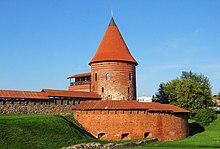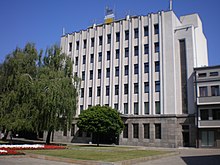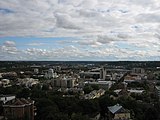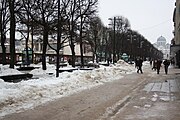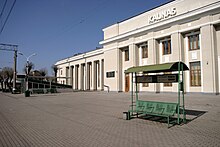Kaunas
| Kaunas | |||
|
|||
| State : |
|
||
| District : | Kaunas | ||
| Municipality : | Kaunas | ||
| Established : | 1361 | ||
| Coordinates : | 54 ° 54 ' N , 23 ° 56' E | ||
| Height : | 47 m | ||
| Area (place) : | 157 km² | ||
| Inhabitants (place) : | 315.003 (2021) | ||
| Population density : | 2,006 inhabitants per km² | ||
| Time zone : | EET (UTC + 2) | ||
| Telephone code : | (+370) 37 | ||
| Postal code : | 44xxx - 52xxx | ||
| License plate : | K | ||
| Status: | Borough | ||
| Structure : | 11 Seniūnijos ("offices") | ||
| Mayor : |
Visvaldas Matijošaitis ( Vieningas Kaunas ) |
||
| Website : | |||
|
|
|||
Kaunas ( German outdated Kauen , Russian Ковно Kowno , Belarusian Коўна Kouna , Polish Kowno ) is the second largest city in Lithuania and the center of the Kaunas administrative district with over 315,000 inhabitants (as of 2021) . It has the status of a township , so it has an elected mayor and city council. It is surrounded by the Kaunas Rajonggemeinde, of which it is the administrative seat.
In addition to a diverse economy, favored by the city's traffic situation, there are several universities and many galleries in Kaunas. Textile art in particular , whose roots lie in the traditionally important textile industry, is strongly represented in the city, which is also reflected in the large, now internationally highly regarded Kaunas textile art biennial . The town is in 2022, together with the Luxembourg Esch-sur-Alzette and the Serbian Novi Sad , European Capital of Culture .
geography
position
Kaunas is located at the confluence of the Memel ( Lithuanian Nemunas ) and Neris rivers about 100 km west of the Lithuanian capital Vilnius near the geographic center of the country in the Central Lithuanian Lowlands . Above the city, the Memel has been dammed into the Kaunasser Sea since 1959 , in the west of the city there is the Lampėdis , an approximately 125 hectare large lake north of the Memel, which arose from a flooded gravel pit and is used as a recreational area.
climate
Kaunas is with its humid climate in the cool temperate climate zone influenced by the continental climate . In the climate classification it is classified as DfB, that is:
- (D) the coldest month has a temperature of less than −3 ° C, the warmest month is over 10 ° C,
- (f) all months are humid and
- (B) the temperature is below 22 ° C, but there are at least four months that are warmer than 10 ° C.
The average annual temperature in the city is around 6 ° C. Although the annual precipitation is only 609 mm (for comparison Cologne : 798 mm), it is higher than the evaporation, which is why a humid climate prevails.
The warmest months are July and August with an average of 18.2 ° C and 17.5 ° C, the coldest months are January and February with an average of −3.3 ° C and −3.1 ° C. Most of the precipitation falls in the months of June and July with an average of 74 mm and 71 mm respectively, the lowest in February with an average of 27 mm.
| Kaunas | ||||||||||||||||||||||||||||||||||||||||||||||||
|---|---|---|---|---|---|---|---|---|---|---|---|---|---|---|---|---|---|---|---|---|---|---|---|---|---|---|---|---|---|---|---|---|---|---|---|---|---|---|---|---|---|---|---|---|---|---|---|---|
| Climate diagram | ||||||||||||||||||||||||||||||||||||||||||||||||
| ||||||||||||||||||||||||||||||||||||||||||||||||
|
Average monthly temperatures and rainfall for Kaunas
Source: wetterkontor.de
|
||||||||||||||||||||||||||||||||||||||||||||||||||||||||||||||||||||||||||||||||||||||||||||||||||||||||||||||||||||||||||||||||||||||||||||||||||||||||||||||||||||||||||||||||||||
story
middle age
A Lithuanian castle at the mouth of the Neris in the Memel was mentioned for the first time in 1361 . This castle was repeatedly conquered or destroyed by knights of the Teutonic Order , but always immediately rebuilt by the Lithuanians. The main reason for the Lithuanian Wars of the Teutonic Order and its attacks on Kaunas was the attempt by the Order to combine its territories in East Prussia and Livonia in order to establish a unified and compact area of rule from Estonia via Livonia to East Prussia. On this north-south axis, the castle in Kaunas represented an important obstacle to the ambitions of the Teutonic Order. With the crushing defeat of the Teutonic Order in the Battle of Tannenberg against the united Lithuanians and Poles in July 1410, this conflict turned in favor of the Lithuanians decided.
The city then lost its importance as a fortress, but experienced a boom as a trading city. After the settlement had already received Magdeburg city rights in 1408 , a Hanse office was opened in 1440 . The handicrafts came to trade and the previously strategically important and hard-fought fortress settlement became a conveniently located, rich and large city in the Polish-Lithuanian state .
Modern times
The 17th and 18th centuries brought hard times for Kaunas: from 1655 to 1661 the city was occupied by Russian troops, in 1701 by the Swedes . Fires destroyed the city in 1670 and 1732, and the plague raged repeatedly .
Since the 16th century, Kaunas, like many places in today's Lithuania, developed into an important Jewish center and thus played a role in the history of the Jews in Lithuania . After a pogrom in 1761, the Jews relocated from the ghetto ordered to them in the city center to the suburb of Slobodka, and Slobodka then became the term for a "Talmudic training center of European standing".
In 1900 the proportion of Jews in the population of Kaunas was around 37%. The Choral Synagogue has been preserved from that time .
After Kaunas during the third partition of Poland had fallen to Russia in 1795, the city was 1,831 Russian Gouvernementshauptstadt the provinces Kovno . In 1879 the Russians began to develop the city into a fortress, a wreath of seven forts and nine batteries along with other fortifications were drawn around the city, to which an eighth fort was added in 1889.
Extensive expansion of the fortress began in 1912; due to the First World War , only Fort IX was completed before the German army conquered the city in 1915. In 1918, Lithuania declared itself independent under German occupation, and in December a city council was elected for the first time, with all men and women aged 20 and over being entitled to vote. In 1920, Polish troops intervened in Lithuania in the Polish-Lithuanian War , occupied the traditional Lithuanian capital Vilnius, which had a predominantly Polish-speaking population, and incorporated the entire Vilnius region into Polish territory, which was justified by the population composition there. Kaunas was therefore the provisional capital of Lithuania from 1920 to 1940 (Laikinoji Sostine) .
Following up on the ideas of the settlement movement , the doctor and educator Siegfried Lehmann founded a Jewish children's home in Kaunas in 1921 , which mainly looked after war orphans. Together with his wife, the doctor Rivkah Rebecca Klivanski († 1959), Lehmann set off for Palestine with a group of young people who were educated here according to reform-pedagogical and Zionist ideals and also trained in crafts . There they founded the children's and youth village Ben Shemen in 1927, which still exists today .

In 1940 the Red Army occupied the city. This was followed by deportations, especially of the Lithuanian educated and property classes, to the interior of the USSR. In June 1941 the German Wehrmacht marched in , which remained as an occupying force in the town that the Germans called Kauen until the summer of 1944 . Immediately after the invasion of the Wehrmacht, Lithuanian nationalists and mass murders of Jews on the street, promoted or tolerated by the German authorities ( Kaunas pogrom ). The Jewish population was soon crammed into the newly created Slobodka ghetto (= Kauen concentration camp) on the other side of the Neris (today: Vilijampole district) and successively murdered in three nearby forts (memorial in Fort IX ) or deported to other concentration camps. Later there was a prisoner of war camp 296 in the city for German prisoners of war of the Second World War . Seriously ill people were cared for in the prisoner-of-war hospital in 1245 . In 1944 Lithuanians also fled Kaunas before the Red Army returned to Germany. From 1940 - interrupted by the German occupation - until the regaining of Lithuanian independence, Kaunas belonged to the Lithuanian Soviet Republic , whose capital again became Vilnius.
In the course of the reform of the administrative division of Lithuania in 1995, today's municipality was created. The eleven Seniūnijos (boroughs) were established in 2000. Today the city is primarily an industrial, educational and scientific location. Due to its location, it is the main transport hub in Lithuania.
Population development and structure

In 2011 lived in Kaunas:
- 93.6% Lithuanians
- 3.8% Russians
- 0.4% Poland
- 0.4% Ukrainians
- 0.2% Belarusians
|
|
|
|
|

Politics and administration

Kaunas is the seat of the administration of the municipality Kaunas as well as the district municipality Kaunas surrounding the city .
List of mayors since 1921
- 1921–1931: Jonas Vileišis
- 1931: Juozas Vokietaitis
- 1932-1933: Antanas Gravrogkas
- 1933-1939: Antanas Merkys
- 1940: Antanas Garmus
- 1940–1990: no freely elected mayors
- 1990-1991: Vidmantas Adomonis
- 1991-1992: Vilimas Čiurinskas
- 1992–1995: Arimantas Račkauskas
- 1995: Rimantas Tumosa
- 1995–1997: Vladas Katkevičius
- 1997: Alfonsas Andriuškevičius
- 1997-2000: Henrikas Tamulis
- 2000: Vytautas Šustauskas
- 2000: Gediminas Budnikas
- 2001–2002: Erikas Tamašauskas
- 2002–2003: Giedrius Donatas Ašmys
- 2003-2007: Arvydas Garbaravičius
- 2007–2011: Andrius Kupčinskas
- 2011: Rimantas Mikaitis
- 2011–2015: Andrius Kupčinskas
- since 2015: Visvaldas Matijošaitis
Townships
The city covers an area of 15,700 hectares. Around 8,329 hectares of this are parks, gardens, protected areas and agricultural land. Kaunas has a city center with a 2.5 km long pedestrian zone, which, lined with cafes, galleries and boutiques, connects the medieval old town with the new town of the 19th century. Kaunas is divided into eleven Seniūnijos (parish, municipality, literally "body of elders"):
| City district (seniūnija) | resident | Area in km² |
District (Miesto Dalis) |
|---|---|---|---|
| Aleksoto seniūnija | 20,000 | 24 | Aleksotas , Birutė , Freda , Kazliškiai and Marvelė |
| Centro seniūnija | 14,733 | 4.58 | Naujamiestis and Senamiestis |
| Eigulių seniūnija | 40,000 | 14.5 | Eiguliai , Kalniečiai and Kleboniškis |
| Dainavos seniūnija | 54,000 | 5.28 | Dainava |
| Gričiupio seniūnija | 25,000 | 3.81 | Gričiupis |
| Panemunės seniūnija | 16,000 | 24.77 | Panemunė , Rokai , Vaišvydava and Vičiūnai |
| Petrašiūnų seniūnija | 13,000 | 28.46 | Amaliai , Naujasodis , Palemonas and Petrašiūnai |
| Šančių seniūnija | 22,000 | 7.41 | Aukštieji Šančiai and Žemieji Šančiai |
| Šilainių seniūnija | 57,000 | 25.33 | Smėliai , Milikoniai , Linkuva , Romainiai and Sargėnai |
| Vilijampolės seniūnija | 26,400 | 14.38 | Lampėdžiai , Panerys , Veršvai and Vilijampolė |
| Žaliakalnio seniūnija | 25,663 | 7.35 | Žaliakalnis |
Town twinning
Kaunas has partnerships with the following 27 cities and local authorities:
education
Universities and colleges
Kaunas is the seat of several universities and several colleges. The largest of these is the Technical University of Kaunas (KTU). There are also:
- the general Vytautas Magnus University
- the Lithuanian University of Health Sciences (formerly the Kaunas University of Medicine and Veterinary Academy of Lithuania , Lietuvos veterinarijos akademija )
- the Agricultural University of Lithuania (Lietuvos žemės ūkio universitetas)
- the Lithuanian Sports University (Lietuvos sporto universitetas) .
Added to that come Arts Faculty Kaunas (Kauno dailės fakultetas) with its renowned Textile Art Department and some technical colleges, colleges (for example, college Kaunas , Technical College , College of Forestry and Environmental Engineering , Cooperation College , Kolping College , V. A. Graičiūnas-School of Management ) .
The Kaunas Military Aviation School existed from 1932 to 1940.
Sports
Kaunas is the seat of the Lithuanian National Stadium, S.Dariaus and S.Girėno Stadium , where matches of the Lithuanian national football team are played. In football, the city is still home to record champions FBK Kaunas and second division club FK Atletas Kaunas .
In the national sport of basketball , BC Žalgiris was three times Soviet champion in the 1980s. In the 1990s, the club was a Lithuanian series champion and achieved great success internationally. Today it belongs to the national sports idol Arvydas Sabonis .
The handball club HC Granitas Kaunas won the EHF Cup in the Soviet times in 1987 and has recently taken part regularly in the EHF Champions League. Like BC Žalgiris, he plays in the Kaunas sports hall (KSH), which with a capacity of almost 4,000 spectators also meets international requirements.
In 2011 the modern multi-purpose arena Žalgirio Arena with up to 15,000 seats was opened.
KSK-Kultus Kaunas was a sports club of the German minority in Kaunas. It was created in 1929 after the two clubs Kownoer Sport Klub and Kultus Kaunas merged. The exact date of its dissolution is not known.
business


After the Lithuanian capital Vilnius , Kaunas is one of the most important economic centers in the country. Numerous international companies from various industries have a local branch in Kaunas, such as Kraft Foods , Stora Enso or Fazer , energy company Kauno energija , Lithuanian sporting goods manufacturer Audimas , furniture manufacturer Kauno baldai , confectionery factory Mondelez Lietuva Production , spirits manufacturer Stumbras , association of credit unions Lietuvos centrinė kredito unija , Vitaresta YIT Kausta , the Volfas Engelman brewery , many transport companies (such as bus companies Kauno autobusai and Kautra , road construction companies Tiltra Group , Kauno tiltai , Kelių priežiūra ), trading companies such as ACC Distribution and Imlitex Holdings . The airlines Air Lithuania and Apatas Air and the Lithuanian bank Ūkio bankas used to be based here.
In addition, numerous local companies have their headquarters in the city, such as the hardware store chain Kesko Senukai Lithuania , the food manufacturer Vičiūnų grupė , the agricultural groups such as KG Group , Lytagra , Agrokoncerno grūdai and Agrokoncerno grupė , the electronics manufacturer ACME or the pharmaceutical company Sanitas as well Pharmacy chains Eurokos and Gintarinė vaistinė .
In the Kaunas Free Economic Zone , many foreign and domestic companies are located.
Kaunas Free Economic Zone
German companies
- Continental AG : Electronics components, 1,000 employees (planned)
- Hella : automotive supplier, 250 employees
- Hellmann Worldwide Logistics : Transport and logistics (60 employees)
- Lidl logistics center (130 employees)
Other
- DPD Lietuva
- Hollister : Medical Technology, USA
- RUN Engineering, USA
- Finnfoam : Building Materials, Finland
- Fitsout UAB: furniture manufacturer and interior design services, 300 employees
- Axioma Metering UAB: measuring devices (200 employees)
- Ryterna UAB: garage door
- Aibė
- Aconitum UAB: Pharma
- Pienas LT: dairy company, largest agricultural cooperative in Lithuania
Culture
Kaunas is 2022, together with the Luxembourg Esch-sur-Alzette , European Capital of Culture in.
Museums
The most famous museum in Kaunas is the Čiurlionis Museum , dedicated to Mikalojus Konstantinas Čiurlionis , the great composer and painter of the country. Here you can not only look at the artist's paintings, but also listen to his music in a specially designed room. A few steps from the Čiurlionis Museum on the other side of the street is the Devil Museum with a worldwide unique collection of devil figures.
In the Zilinskas gallery directly opposite the Sobor , the neo-Byzantine church at the eastern end of the pedestrian zone, Western European paintings exhibited, such as B. Pictures by Max Liebermann and Franz Marc .
George Maciunas , Fluxus co- founder, companion of Joseph Beuys and also a superstar of the contemporary art scene, was born in Kaunas. A small permanent exhibition is dedicated to him in the municipal art gallery in Kaunas at Donelaicio gatve 16, also near Sobor.
The Maironis Museum is the central literary museum in Lithuania. It collects and preserves the evidence of Lithuanian literature from its beginnings to the present.
The Vytautas Magnus Military Museum houses an exhibition on Lithuanian military history, focusing mainly on the period before the partitions of Poland and the period from the final stages of World War I to the Soviet occupation of Lithuania in 1940 and the resistance that lasted until 1953 Includes Lithuanian partisans called forest brothers . The collaboration between the Lithuanian military and the German armed forces is only mentioned marginally. Events such as the Soviet reconquest of Lithuania in the summer and autumn of 1944 are completely excluded. The highlight of the exhibition is the wreckage of the plane with which the pilots Darius and Girėnas tried to fly non-stop from New York to Kaunas in 1933. The museum building is in a dilapidated condition.
The Historic Presidential Palace ( Lithuanian Istorinė Prezidentūra ) documents the country's first years of independence after the First World War, as well as the life of the presidents since 1990.
The Lithuanian Open-Air Museum , one of the largest open-air museums in Europe with historical buildings from all parts of Lithuania, is located on the banks of the Kaunasser Meer reservoir .
There is also a zoological museum, the Tadas-Ivanauskas-Zoomuseum Kaunas , founded in 1919 . Live animals can be seen in the Kaunas Zoo , which was also founded in 1938 by the zoologist Tadas Ivanauskas in the Ąžuolynas Park, and is the only one in Lithuania.
Places of the old town
The old town Kaunas (lit. senamiestis ) houses many well-preserved old buildings. On the main square, the historic town hall square , are the Peter and Paul Cathedral , the Jesuit Church and the historic town hall , which is known colloquially as the "White Swan" because of its tall, white shape and is used as a registry office ("wedding palace").
Jesuit church and grammar school on the town hall square in Kaunas
On the north side of the Town Hall Square, house number 27 is the Meno Parkas Gallery of the Lithuanian Artists Association , where exhibitions of contemporary art are regularly presented. In M. Valanciaus gatve 21 , a few meters behind the cathedral, has the "Galerija Balta", the Gallery of Textile Art Guild Tekstilininkų ir dailininkų Gildija , the Association of Lithuanian textile artists based. In the street Šv. Gertrūdos 58 is the Kaunas Multinational Cultural Center .
Also not far from the town hall square are the ruins of Kaunas Castle and St. George's Church on the Neris. In a side street of the Rathausplatz facing the Memel is the Perkunas House, a late Gothic town house in which the students from the nearby Jesuit grammar school organize guided tours during the summer.
Two funicular railways that were built in the interwar period still run on the high terraces above the Memel valley opposite the old town .
Places of history
On the eastern outskirts of Kaunas, near the reservoir Kaunasser Meer (Kauno marios) , lies the Pažaislis Monastery , which after its renovation is one of the most beautiful and unusual sacred buildings in Lithuania.
The memorial in the IX. Fort on the northern outskirts. In it and two other forts, around 18,500 to 50,000 Jewish people from Lithuania and all of Europe were murdered during the German occupation (see section Modern Times ). The exhibition in the fort not only deals with the events in Kaunas, but also deals with the murder of the Jewish population in Lithuania as a whole.
In 1933, the corpses of the Lithuanian Atlantic pilots Darius and Girėnas, who had been transferred from Germany, were received by a huge crowd at the former airport in the Aleksotas district . The two had had a fatal accident a few days earlier, coming from New York, about 150 km east of Berlin after an excellent flying performance. In the Lithuanian Aviation Museum Lietuvos Aviacijos Muziejus , which is part of the airport, there is, among many other things, an extensive collection of material on this flight and the gigantic funeral ceremonies in Kaunas that followed.
music
traffic
One of the locational advantages of Kaunas is its location as the country's central (road) traffic junction. Running from south to north, the so-called “Via Baltica” ( European route 67 ), which leads from Warsaw via Riga and Tallinn to Helsinki , meets the west-east main route, the stretch of motorway from Klaipėda to Vilnius, which runs in the Continuation via Minsk leads to Moscow. Kaunas is currently more conveniently located than Vilnius, which is close to the EU's external border with Belarus and therefore in a kind of “dead corner” in terms of traffic.
Long-distance buses
There are long-distance bus connections to all major Lithuanian cities and many small towns, as well as to all neighboring countries and many major cities in other countries of the European Union . The buses to Vilnius run every 30 minutes during the day. The bus station is just a few minutes' walk from the Lithuanian Railway Station.
Local public transport (ÖPNV)
Buses and trolleybuses operate in Kaunas' urban transport system . The Lietuvos Gelezinkeliai (Railway) operates a small S-Bahn -like system of suburban trains. What should be emphasized is the existence of a very extensive regular taxi network with over 130 lines, which handles the mass of public transport in Kaunas and the surrounding area.
railroad
The Kaunas railway station is the gateway to the city railway traffic. There are connections to Vilnius , Šiauliai , Kybartai , Marijampole and, from 2022, to Białystok .
An EU-funded " Rail Baltica " line reached Kaunas in 2021. The further route towards Tallinn is in the planning phase (planned completion in 2025).
The Kaunas narrow-gauge railway was in operation from 1919 to 1935.
The Kaunas-Palemonas freight yard ("Kauno Intermodalinis Terminalas", KIT) is located in the Petrašiūnų seniūnija district .
Air traffic
Various European destinations are served from Kaunas Airport ( IATA airport code : KUN).
shipping
Kaunas can be reached by barges from the Curonian Lagoon ( Memel ) via the Memel ( lit.Nemunas ). However, unlike in Soviet times, inland shipping has so far not played a significant role. After the old cargo port was privatized and closed due to unprofitability, a new port was designed for cargo shipping. There is also the winter harbor and the marina .
Another problem is that the lower reaches of the Memel from Smalininkai is the Lithuanian and thus also an EU external border to Russia (formerly East Prussia). There are plans to resume summer passenger traffic on a speedboat from Kaunas to Nidden on the Curonian Spit , which was discontinued a few years ago.
Personalities
Daughters and sons of the city
Well-known personalities who were born in Kaunas include the former President of the Republic of Lithuania Valdas Adamkus (* 1926), the wife of the Hitler assassin Count von Stauffenberg Nina von Stauffenberg (1913-2006), the former Foreign Minister of Israel Mosche Arens (1925–2019) and the philosopher Emmanuel Levinas (1906–1995).
Honorary citizen
- 1993: Vincentas Sladkevičius (1920–2000), Archbishop of Kaunas (1989–1996)
- 1994: Vytautas Landsbergis (* 1932), first head of state in Lithuania after regaining independence in 1990
- 1995: Bernardas Brazdžionis (1907–2002), writer
- 1997: Algirdas Šocikas (1928–2012), European amateur boxer champion in 1953 and 1955 in the heavyweight division
- 1997: Arvydas Sabonis (* 1964), former basketball player
- 1997: Sigitas Tamkevičius (* 1938), Archbishop of Kaunas (1996-2015)
- 2003: Rimantas Ruzas (1959–2002), Lithuanian politician
- 2005: Aleksander Kwaśniewski (* 1954), President of the Third Polish Republic (1995–2005)
- 2006: Valdas Adamkus (* 1926), President of the Republic of Lithuania (1998–2003, 2004–2009)
- 2015: Jurgis Brėdikis (* 1929), cardiac surgeon, professor, former politician (health minister) and diplomat
Others
The asteroid (73059) Kaunas , discovered in 2002 by the Lithuanian astronomers Kazimieras Černis and Justas Zdanavičius , was named after the city in 2005.
literature
- Manfred Hellmann: Art. Kaunas . In: Lexikon des Mittelalters 5 (1991), p. 1087.
- Julija Reklaitė: Kaunas Architectural Guide: Buildings from 1918 to the present day. DOM publishers, Berlin 2016, ISBN 978-3-86922-441-1 .
Web links
- Official website of the city (Lithuanian, English)
- Official website of the city (Lithuanian, English)
- Textile Art Biennale Kaunas (official website)
- Kaunas Art Institute (official site)
- Aviation Museum (official site)
- Overview of the fortifications (English)
Individual evidence
- ↑ Seniūnijos
- ↑ January Otrebski: The place names Kovno, and Olita in Lithuania . In: Contributions to Name Research Ser. NS 6 (1971) p. 154 f.
- ↑ gyventojų skaičiuotojams
- ↑ a b Kaunas2022.eu , official website (English, Lithuanian)
- ↑ Tūkstančiai kauniečių išbandė Lampėdžio ežero tvirtumą (thousands of Kaunas residents test the strength of the ice on the Lampėdis), January 15, 2017 on kauno.diena.lt, accessed June 21, 2020
- ↑ Algirdas Zalnierius: The first castle of Kaunas . In: Albinas Kuncevicius (ed.): Conference Castella Maris Baltici 6, Vilnius 2004, pp. 219-230.
- ↑ Walther Stein: From the German office in Kowno . In: Hansische Geschichtsblätter 22 (1916), pp. 225–266.
- ↑ Encyclopaedia Judaica: Judaism in the past and present. Berlin 1932, Volume 10, p. 358.
- ↑ Götz Borgwardt: Bernhard Schapiro (1888–1966): Talmudic scholar - doctor - pioneer of the hormone treatment of cryptorchidism. In: Würzburger medical history reports 23, 2004, pp. 393–411; here: p. 395.
- ^ PR Magocsi: Historical Atlas of Central Europe . University of Washington Press, Seattle 2002, p. 109.
- ↑ Moderniosios savivaldos formavimasis Kaune (Formation of a modern self-government in Kaunas), Archives of the Kaunas district, accessed June 21, 2020
- ^ DÖW - Erinnern - Photos and Documents - 1938 - 1945 - Pogroms in Kowno (Kaunas / Kauen), June 1941. Retrieved on June 7, 2021 .
- ↑ cf. the series of pictures on Kaunas in the Federal Archives and at the picture agency bpk (department of the Berlin State Library - Prussian Cultural Heritage); z. B. “A group of Jewish women is led to execution by members of the Lithuanian activist front.” , “Mass shooting of Jews by members of the Lithuanian activist front.” , “Pogrom in Kovno (Kaunas) from 23-28 June 1941. A young Lithuanian kills Jews with a crowbar " , " Kaunas - Public murder (slaughter) of Jews by Lithuanian nationalists after the invasion of the German Wehrmacht (pogrom). " .
- ^ Andrej Angrick : The importance of terror and murder in the concept of occupation policy in the Baltic States. In Sebastian Lehmann-Himmel, Uwe Danker , Robert Bohn (eds.): Reichskommissariat Ostland. Crime scene and souvenir . A publication of the Institute for Schleswig-Holstein Contemporary and Regional History of the European University of Flensburg and the Military History Research Office . Paderborn 2012, ISBN 978-3-506-77188-9 , pp. 73ff.
- ↑ Erich Maschke (Ed.): On the history of the German prisoners of war of the Second World War. Verlag Ernst and Werner Gieseking, Bielefeld 1962–1977.
- ↑ Kas penktas klaipėdietis yra rusas, vilnietis - kas aštuntas.
- ↑ Statistics departamento duomenys
- ↑ Statistics departamento duomenys
- ↑ City districts on kaunas.lt
- ↑ Kauno miesto savivaldybė Miesto partneriai. Retrieved April 9, 2019 .
- ↑ 1940–1944 Timeline – Kovno. Archived from the original on January 16, 2009 ; Retrieved March 19, 2014 .
- ↑ Line network Lithuania
- ↑ KIT
- ↑ JPL Small-Body Database Browser NASA, accessed November 11, 2017




